Are you in the market for a tongue scraper? Want to know the best way to get rid of bad breath and clean away bacteria? Or just wondering if tongue scraping is a necessary part of your oral hygiene routine in the first place?
We’re here to help answer all these questions and more in our comprehensive guide to cleaning your tongue for your oral health. Keep reading for information about:
- The benefits for your health
- How to find the best scraper for you in the US
- The best tongue scraping technique
- How to clean the back of your tongue without gagging
- Other ways to keep up the health of your tongue
- When to see your dentist
Our aim is to help you improve your oral health by making better decisions about how you care for your mouth.
Should you clean your tongue?
The concept of tongue scraping is relatively new to the US but has been practiced in many cultures for centuries, and 39% of people worldwide already brush their tongue regularly.
Tongue scraping is a bit different than brushing, though, and chances are it’s not something your dentist has recommended; flossing and twice-daily brushing are probably higher on their agenda when it comes to oral health. However, start incorporating tongue scraping into your daily oral hygiene routine and you may notice a number of benefits.
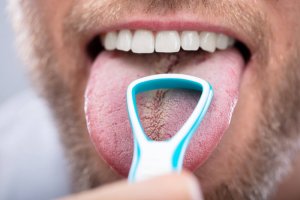

The aim of this device is to scrape tongue residue, the buildup of bacteria, debris and dead cells which is constantly accumulating, and is generally bad for your health and can even affect your taste. This coating on your tongue can be made worse by a number of factors including:
- Smoking
- Certain medications
- Dry mouth
- Oral thrush
- Insufficient oral care
The bacteria which build up on the tongue can form plaque, which in turn contributes to bad breath, tooth decay, gum disease and overall bad health. According to this study from 2014, tongue scraping was found to reduce the number of bacteria in the coating, although it didn’t inhibit the formation of dental plaque. Thus, the study concluded, tongue scraping should be performed alongside tooth brushing to reduce the number of bacteria in the mouth.
Benefits of tongue scraping
Research on the benefits is still quite limited, but scraping at least twice a day could help improve any of the following:
- Bad breath: Bacteria and food particles embedded in crevices are a major cause of bad breath. Clean bacteria and food off, and your mouth will feel much fresher. Read our full guide to bad breath causes and treatments for more tips, plus warning signs of a more serious problem.
- Appearance: A heavy white buildup on your tongue looks and feels unpleasant. Use a tongue scraper and make sure you’re drinking enough water.
- Sense of taste: A physical coating over your taste buds might be stopping you from experiencing the full taste of the food you eat.
- Overall better oral health: A clean tongue means fewer bacteria in your mouth overall, which can help slow the progress of dental caries and gum disease.
If you think you’re suffering from chronic bad breath (halitosis) or your tongue is painful or discolored, you should visit your dentist for a health checkup and find out how you can improve it.
Can you brush your tongue the way you brush your teeth?
Toothbrushes are great for scrubbing tooth enamel, but not your tongue. This means that they are less effective than tongue scrapers at removing volatile sulfur compounds (VSCs) – a contributor to bad breath. This study from 2004 only monitored 10 people but found that a tongue scraper was 67% more effective at removing VSCs.
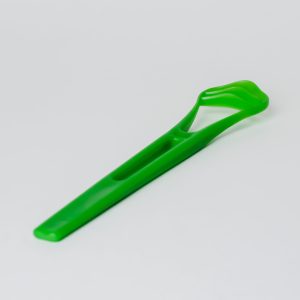

Secondly, chunky brush heads can easily trigger your gag reflex when you try to clean the back of your tongue. They’re just not designed to be used in that part of your mouth.
What about a toothbrush with a built-in cleaner?
Perhaps you have tried to brush your tongue using a toothbrush with a tongue brush on the reverse. This might be slightly more effective at removing bacteria and getting rid of bad breath than just brushing your tongue with standard bristles, but the problem with gagging remains. Plus, it’s difficult to know if you’ve effectively cleaned the full surface of your tongue.
If you haven’t had much success with this method and want to know how to brush your tongue without gagging, the solution could be to buy a tongue scraper. Not only are these devices much thinner than a standard brush, they also make scraping simpler and quicker.
How do you use it?
The best way to clean your tongue to get rid of bacteria and improve bad breath is by tongue scraping following these simple steps:
- Stick your tongue as far out of your mouth as it will comfortably go.
- Place the scraper as far back as you can without gagging.
- Exert enough force that the scraper sits flat against your tongue (but not so much that it hurts).
- Slowly pull it forwards to the tip of your tongue.
- Spit out any saliva and debris that has accumulated on your tongue, and rinse or wipe any gunk off the scraper.
- Repeat several times, ensuring you have scraped the whole surface.
- Wash your tongue scraper under running water and leave it out to dry.
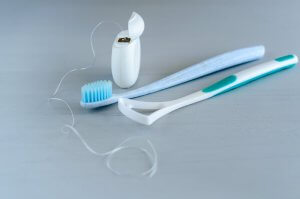

Make tongue scraping part of your daily oral care
Now that you know how to improve bad breath and get rid of bacteria by using a tongue scraper, it’s easy to add this to your daily hygiene routine. The whole process should take less than a minute. You can clean your tongue twice a day, when you brush your teeth (check if you’re brushing your teeth correctly here). But in fact, you can scrape more often than this. People who are especially conscious of bad breath-causing bacteria might clean their tongues after drinking coffee, smoking, or eating strongly scented foods, for instance.
Note that you shouldn’t rinse your mouth with water or mouthwash if you have just brushed your teeth. This washes away the beneficial ingredients in your toothpaste. If you prefer to rinse your mouth after scraping then do it before, not after, brushing your teeth.
If you have problems with gagging when you clean the back of your tongue, you’re not alone. After you get used to the sensation of scraping your tongue, you might find it becomes easier to place the scraper further back in your mouth without gagging. Some people find that a heavier tongue scraper is less likely to trigger their gag reflex than a lighter plastic one.
Choosing the best tongue scraper for you
Tongue scrapers come in various different shapes and materials, the main differences being between plastic and metal models. You’ll find the best selection of tongue cleaners for tongue scraping in the US if you look online. Below we take a look at some popular options and explain how you can decide on the best model for you.
Plastic tongue scrapers
Let’s begin with the plastic variety for tongue scraping. These usually have a long handle similar to a toothbrush handle, and a tip with one or more bars which scrape along the tongue. They might also have small bristles to help dislodge particles from the surface.
Plastic cleaners of this type are too small to clean the whole tongue at once, so require several strokes along each area for effective scraping. They need to be replaced every 3-4 months, just like a normal brush head – or sooner if they become damaged or visibly dirty.
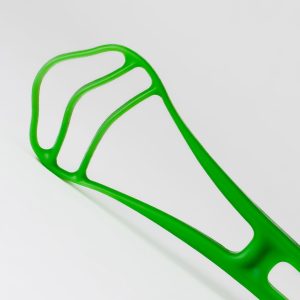

Our top pick for tongue cleaners and scrapers is the TePe GOOD Tongue Cleaner. We love it for a variety of reasons. First, it’s made from bio plastic, and it is designed to complement the tongue’s natural shape, reducing gag reflex and making it easier to reach near the back.
There are three cleaning blades that remove more bacteria with a single movement. Plus, it’s dishwasher-safe! One happy reviewer says:
“A good cleaning of your tongue is a must-have for oral hygiene and to reduce bad breath. The triple head allows you to clean your tongue quickly and efficiently in just a few passes. I will buy it again.”
If you’re in the market for a cheap, no-frills plastic model, this set of 3 from BreathRx should do the job. They are great value compared to some others, and the rubber grips on the handle make them easy to hold.
For a slightly different approach to scraping, try the DenTek Orabrush 2 in 1 cleaner and scraper. This looks a bit like a big, flat brush. You use the super-soft bristles to dislodge debris, then use the built-in scraper to clear it away.
Many users say it is gentler than a traditional tongue scraper – which some see as a pro and others as a con. But the general consensus is that the brushing and scraping combined do leave you feeling really clean. One happy reviewer on Amazon says:
“Best tongue scrubbers I have been able to find yet. Love that it has bristles AND the scraper. Most seem to only have the scrape but without the bristles I dont think my tongue comes out as clean. I have purchased multiple and gave them out in self-care care packages I gave to friends and family for christmas. I have converted so many non-believers over to tongue cleaners!”
In the video below, dental hygienist Whitney talks about how to use a tongue scraper and why Orabrush is her favorite brand. Skip ahead to minute 4:20 to hear about tongue scraping, unless you need a refresher on proper teeth brushing techniques which she includes first.
Metal tongue scrapers
If you want to cut down on plastic waste or take a more natural approach to scraping, a metal tongue scraper may be the best option. These are typically bent into a rounded ‘U’ shape. By holding the two handles, you can accurately position the scraper right at the back of your mouth.
They can clean your whole tongue in one stroke, making the process quick and efficient. A stainless steel or copper tongue scraper should be much longer-lasting than a plastic one, so although they cost a little more, they may work out more cost-effective in the long run.
Copper tongue scrapers
If you’re looking for an Ayurvedic tongue scraper that follows the principles of traditional Indian medicine, a copper one is most authentic. Even if this isn’t an important consideration for you, many people choose copper for its natural antimicrobial properties.
One of the most popular copper tongue scrapers around is the Kosha Ayurveda Tongue Scraper. It has a wide scraping edge to reach across the whole surface, a thick blunt edge for safety, and comfortable grips on the handles to make it easy to maneuver.
It also gets good reviews from people who have had trouble with gagging while trying to clean their tongue with a toothbrush:
” I gag easily but with this I can clean my tongue better than with a toothbrush.”
Copper tongue scrapers can last for many years if cared for properly. The most important thing is to make sure it dries fully after each use. However, some people report tarnishing after just a few months despite following the care instructions.
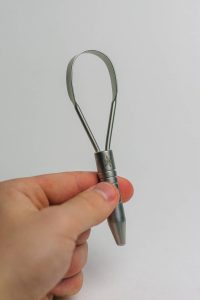

Stainless steel tongue scraper
A more premium option is the Sweeper Model P, which is recommended by dentists. It features an ultra-smooth edge and a sleek profile that minimizes gagging. It is also made from medical grade stainless steel and has a colored silicone ring so you know which is yours. What’s more, these professional cleaners are made in the US.
Another option is a multipack. Some people prefer using a U-shaped scraper and some prefer the single-handle. This set offers the best of both, with two ‘u’-shaped scrapers and two single-handle designs. This could be a great place to start if you don’t have any experience with tongue scraping and are unsure which style would suit you best.
In the table below is a summary of the different aspects to consider when deciding which type is best for you:
| Image | Product | Components | Price |
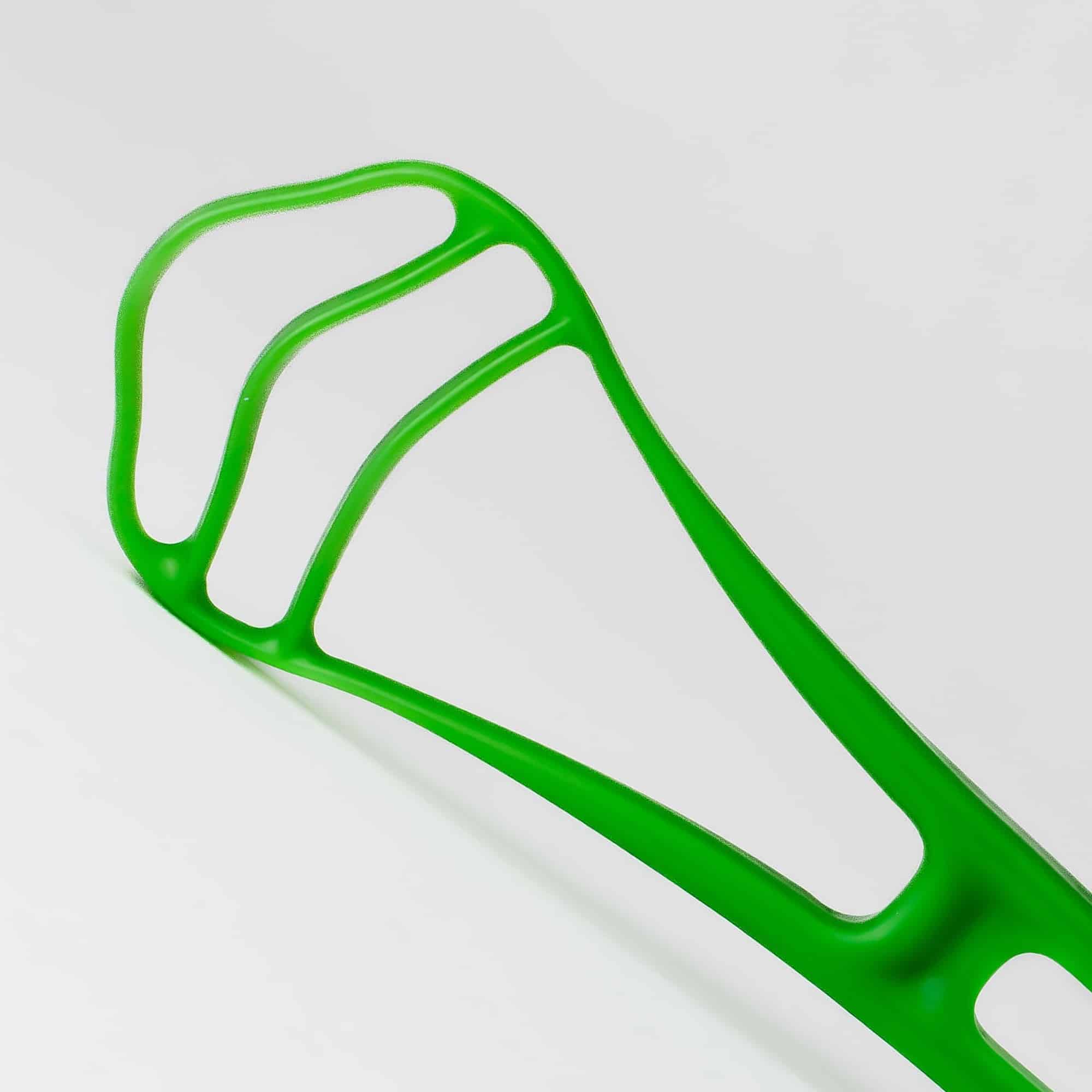  | TePe GOOD Tongue Cleaner | Bio-plastic, 3 gentle blades, ergonomic handle | |
| | BreathRX | Set of 3, low-cost, rubber grip handles | |
| | DenTek Orabrush | Scraper and cleaner, soft bristles | |
| | Kosha Ayurveda | Copper, wide edgem comfortable grips | |
| | Sweeper Model P | Recommended by dentists, made in the US, stainless steel | |
| | Stainless steel tongue cleaner | Stainless steel, colored handles, 2 styles | |
| | Kids tongue cleaner | Fun colors |
Homemade tongue scrapers
If you search for DIY tongue scrapers online, the most common advice you’ll find is simply to use a spoon instead. It’s not a bad alternative, but you may not find the shape of a spoon quite as ergonomic as a proper tongue scraping tool.
It is possible to make a DIY tongue scraper from scratch, like this one. We can’t speak for the safety or effectiveness of tongue scraping with such a device, though, and unless you have a lot of time on your hands you might decide it’s worth just spending those few dollars on Amazon.
Baby tongue cleaner
Is it necessary to clean the tongue of your newborn or toddler?
According to the American Dental Association, it isn’t even absolutely imperative to your dental health for adults to clean their tongues. That being said, If you want to get your baby used to brushing their tongue, you can use a soft gauze to wipe off their tongue with your finger, but you’ll be hard-pressed to find a popular infant tongue cleaner that looks like the adult models.
There are tongue scrapers for kids however, like this one that looks like a lollipop.
Other ways of cleaning your tongue
Many water flossers come with a tongue cleaning tip that emits a spray of water as you clean your tongue. People with a sensitive gag reflex may struggle with this way to clean your tongue, but on the other hand, it can feel like a more hygienic way to do it. Check out our water flosser guide if you want to find one that includes a special tip for this purpose.
Similarly, some premium electric toothbrushes have a special head and a setting specifically for tongue scraping. The Philips Sonicare DiamondClean Smart 9700 is one such model, but you can read our electric brush guide to discover more options.
How to clean your tongue without a tongue scraper
If you find yourself without a tongue scraping tool and in need of a fresher tongue and breath, the edge of a plastic or metal spoon will do quite a good job. Scrape your tongue from the back to the tip and see what you collect.
As we mentioned earlier, you can also brush your tongue with a toothbrush, but this has been shown to be less effective than using a device designed specifically for this purpose.
How to clean your tongue naturally


If you’d prefer not to physically scrape anything along your tongue, you’ll probably find that a mouth rinse is the next best way to clean your tongue and relieve bad breath. There are plenty of natural mouthwashes available to buy in stores and online, or you could try your hand at making your own using baking soda. Our guide to the best mouthwash has more information about all of these options.
Regular use of a mouth rinse is a good way to keep your mouth feeling fresh. It’s also important to ensure you drink enough water, because dehydration can worsen the buildup of bacteria on the tongue.
Conclusion
Although not widely practiced or recommended in the US, and most likely not essential according to your dentist, the various tongue scraper benefits, including relieving bad breath and getting rid of bacteria make it a worthwhile addition to your daily dental care routine.
Our advice is to use a tongue scraper rather than a toothbrush, and experiment with a couple of different styles if you don’t like the first one you use. Generally the flatter it lies against your tongue, the easier you’ll find it to clean your tongue without gagging – especially the back of your tongue.
Don’t forget that you should still brush your teeth twice a day and clean between your teeth daily if you want to keep your mouth in top condition. Regular checkups with your dentist will help identify any more serious problems with your tongue, teeth or gums.
NCBI: Tongue-cleaning methods: a comparative clinical trial employing a toothbrush and a tongue scraper. Consulted 13th January 2024.
BMC Oral Health: Effects of tongue cleaning on bacterial flora in tongue coating and dental plaque: a crossover study. Consulted 13th January 2024.
NCBI: The effect of tongue scraper on mutans streptococci and lactobacilli in patients with caries and periodontal disease. Consulted 13th January 2024.
Mouth Healthy: Tongue Scrapers and Cleaners. Consulted 13th January 2024.
Sunstar: Global Healthy Thinking Report. Consulted 11th September 2024.
NCBI: Tongue-cleaning methods: a comparative clinical trial employing a toothbrush and a tongue scraper. Consulted 13th January 2024.
BMC Oral Health: Effects of tongue cleaning on bacterial flora in tongue coating and dental plaque: a crossover study. Consulted 13th January 2024.
NCBI: The effect of tongue scraper on mutans streptococci and lactobacilli in patients with caries and periodontal disease. Consulted 13th January 2024.
Mouth Healthy: Tongue Scrapers and Cleaners. Consulted 13th January 2024.
Sunstar: Global Healthy Thinking Report. Consulted 11th September 2024.










